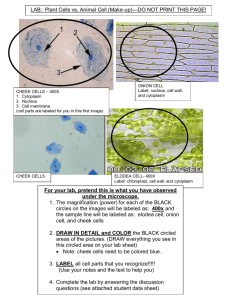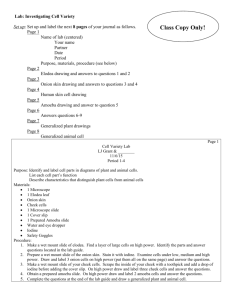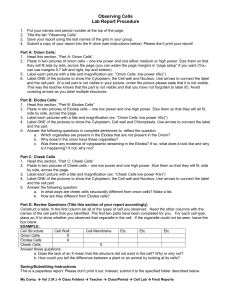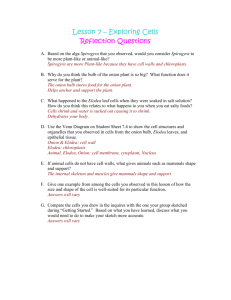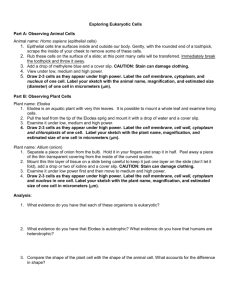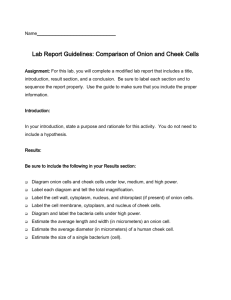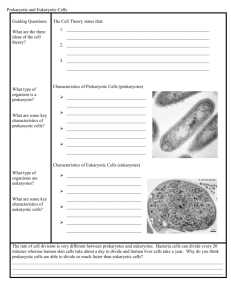Name:
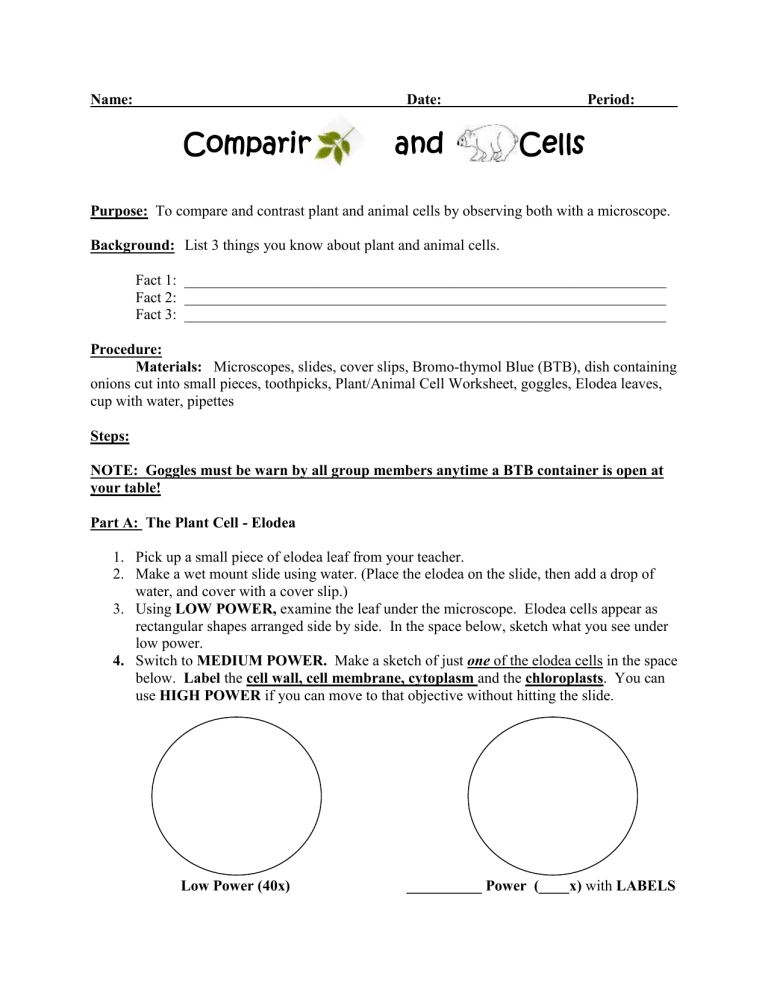
Name: Date: Period:
Comparing and Cells
Purpose: To compare and contrast plant and animal cells by observing both with a microscope.
Background: List 3 things you know about plant and animal cells.
Fact 1: ________________________________________________________________
Fact 2: ________________________________________________________________
Fact 3: ________________________________________________________________
Procedure:
Materials: Microscopes, slides, cover slips, Bromo-thymol Blue (BTB), dish containing onions cut into small pieces, toothpicks, Plant/Animal Cell Worksheet, goggles, Elodea leaves, cup with water, pipettes
Steps:
NOTE: Goggles must be warn by all group members anytime a BTB container is open at your table!
Part A: The Plant Cell - Elodea
1.
Pick up a small piece of elodea leaf from your teacher.
2.
Make a wet mount slide using water. (Place the elodea on the slide, then add a drop of water, and cover with a cover slip.)
3.
Using LOW POWER, examine the leaf under the microscope. Elodea cells appear as rectangular shapes arranged side by side. In the space below, sketch what you see under low power.
4.
Switch to MEDIUM POWER. Make a sketch of just one of the elodea cells in the space below. Label the cell wall, cell membrane, cytoplasm and the chloroplasts . You can use HIGH POWER if you can move to that objective without hitting the slide.
Low Power (40x) __________ Power (____x) with LABELS
Part B: The Plant Cell - Onion
1.
Pick up a small piece of onion from your teacher. Peel the transparent “skin” from the inside of the onion piece.
2.
Make a wet mount slide using BTB instead of water. Place the onion skin on the slide, add a drop of BTB, and cover with a cover slip.
3.
Using LOW POWER, examine the onion skin under the microscope. Onion cells appear as rectangular shapes arranged side by side. In the space below, sketch what you see under low power.
4.
Switch to MEDIUM POWER. Make a sketch of just one of the onion cells in the space below. Label the cell wall, cell membrane, and the nucleus .
Low Power (40x)
Part C: The Animal Cell
Medium Power (100x) with LABELS!
1.
Place a drop of BTB on a clean slide.
2.
GENTLY scrape the inside lining of your cheek with the flat edge of a toothpick. Stir the cheek material into the drop of BTB in order to separate the cells.
3.
Place a cover slip over the stained cheek material. Using low power examine it under the microscope. NOTE: Cheek cells appear as irregularly shaped lumps of material.
4.
Locate an isolated cell under medium power. Make a sketch below of one cheek cell in the space below. Label the cell membrane, nucleus, and cytoplasm.
Medium Power (100x) with LABELS!
Conclusion: Think about and include answers to the following questions in your conclusion.
1.
Describe at least 4 differences between plant and animal cells. (HINT: consider arrangement of cells, cell shape, organelles, etc. in your answer.)
2.
Why did you stir the cheek material in the BTB? Why didn’t you stir up the onion cells?
3.
Why did you need to use BTB on certain slides?
4.
What organelle is missing from the onion cell that was present in the elodea cell?
Why would it not be present in an onion cell, but present in an elodea cell?
5.
What is the function of chloroplasts? Why don’t animal cells have this organelle?
(HINT: How do animals get their energy?)
6.
Is the nucleus always found in the center of the cell? What is the function of the nucleus?
